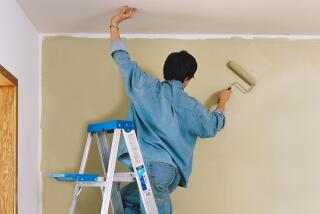A pessimist mulls an ancient passion
It wasn’t until I read two new books on feng shui that I realized the mirror facing my living-room window was bouncing good energy out into the frontyard, my sink and stove were locked in a power struggle and a hunk of my house was completely missing.
I told my husband this, and he cocked an eyebrow and continued to read the paper.
Reading these books about the ancient art of object placement from a Western (read: “narrow”) viewpoint, it’s easy to shake your head at some assertions. Neither book sets out to persuade readers of the merits of these beliefs. Rather, the authors assume you have an interest in the subject. And it’s tough not to be curious as proponents -- and books on the subject -- multiply.
MaryAnn Russell’s stated purpose in “The Feng Shui Factor” is to demystify the Eastern art and make it useful for Western readers. Does she succeed? Partially. Some points remain a mystery. Advice is given without sufficient explanation. For example: If you are living in a home that is next to a hospital, mortuary or cemetery, keep an exterior light on 24 hours a day. Or: Avoid placing pictures of living people on the mantel. Why?
Russell’s advice on exterior feng shui, such as less desirable locations and house shapes, may benefit those serious about the practice who are looking for a home. I simply found it perplexing to read that the irregular shape of my house meant a piece was “missing” (turns out it’s the part that governs wealth, which may explain my bank account). Russell does offer remedies, which include creative landscaping.
Her advice for using feng shui indoors was fun to read and more practical for someone staying put. Lose the clutter, she says. It makes sense, even if you don’t buy the theory behind it (lack of energy circulation may affect your health).
“Sell Your Home With Feng Shui” takes a different perspective -- that of the seller. It centers on incorporating feng shui as a staging technique, and authors Christine Ayres and Cindy Coverdale note that some advice doesn’t apply to those who want to remain in the house. It pinpoints areas of negative feng shui (too many outside stairs to reach the doorway, for example, which may make every walk into the house feel like a struggle). Then it offers fixes to help lure buyers (decorate the landing; create a seating area with plants and a bench part of the way up as a spot to sit and pause).
This book too has advice that may leave novices feeling quizzical. Such as the “Bagua Mirror Cure”: The small, octagonal mirror is “a tool for pushing away energy that doesn’t belong to you and that you do not wish to accept.” The authors say it doesn’t even have to be visible to have an effect: Hang it behind the window draperies and buyers may not even notice the view of the neighbor’s junk-filled yard. And if the property keeps falling out of escrow, putting a weight in the buyer “gua,” or right front area of the property, is said to help.
There is some advice I’ll follow; other advice, perhaps not. I probably won’t remodel my kitchen to move my sink and stove so they’re not in direct opposite alignment (apparently the fire and water elements conflict, causing agitation and arguments). However, I will go ahead and take down that mirror. Never liked it anyway.
Placed toward the center of “The Feng Shui Factor” (symbolizing a balanced view, perhaps?) was a bit of wisdom from the author: Correcting feng shui in your home is just one factor in improving an area of your life. Such corrections can be a catalyst for improvement by compelling you to take action toward change.
Now that I buy.
--
More to Read
Sign up for our Book Club newsletter
Get the latest news, events and more from the Los Angeles Times Book Club, and help us get L.A. reading and talking.
You may occasionally receive promotional content from the Los Angeles Times.









